22 Types Of Dango, Explained
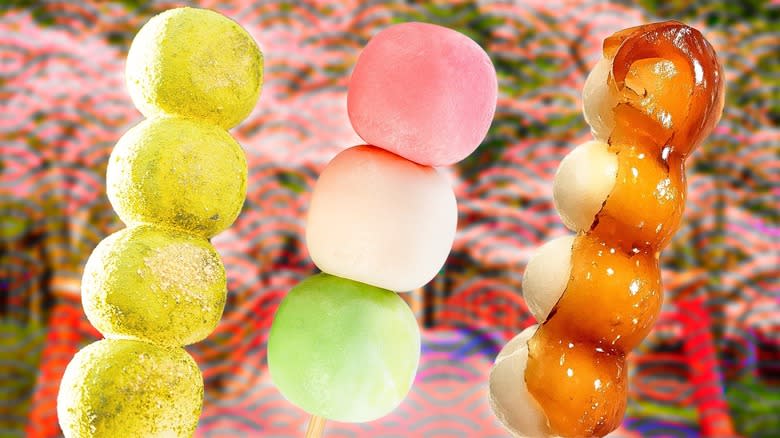
No other branch of Japanese cuisine embodies its penchant for elegance, precision, and seasonality like wagashi. These traditional confections -- mostly crafted from plant-based ingredients -- serve as the perfect companion to a soothing cup of green tea. A popular type of wagashi is dango -- the unassuming bridge between the most sophisticated wagashi and the everyday street food scene. Not to be confused with mochi, another traditional chewy sweet treat, most dango is typically made from short-grain rice flour like joshinko and sometimes mixed with sweet glutinous rice flour such as shiratamako. On the other hand, mochi is made from steaming and pounding rice.
While easily recognizable in your phone's emoji keyboard as small colorful balls on a skewer, these chewy Japanese dumplings have much more to offer. From the iconic mitarashi dango, festive hanami dango, and tsukimi dango to more obscure regional varieties made with soybean flour, sweet potato, and mugwort, there is so matcha to learn. So, whip yourself a cup of tea, settle in, and join us as we navigate through the A to Z of dango, uncovering the diverse and vibrant landscape of shapes, sizes, colors, and flavors, each bearing the mark of Japanese culinary tradition.
Read more: 30 Healthy Snack Ideas That Won't Ruin Your Diet
Anko Dango
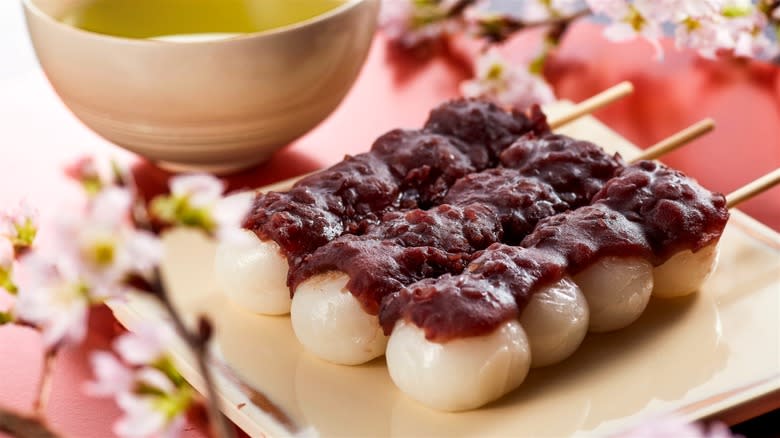
If you are familiar with traditional Japanese sweets (wagashi), then you'll instantly recognize this dango's titular topping. This sweet paste made from adzuki beans shines in various desserts and snacks, usually encased in dough — think fish-shaped taiyaki pastries or pillowy mochi. However, it is smeared over neutral-tasting rice flour-based balls for this type of dango. It's one of the easiest types of dango to make at home, and you have the option of topping it with either chunky (tsubuan), semi-chunky (tsubushian), or smooth (koshian) red bean paste. All three involve boiling adzuki beans, either left whole or mashed until a thick paste forms. You can stop there or strain it through a fine-mesh sieve for koshian. It ends with adding sugar.
Ayame Dango
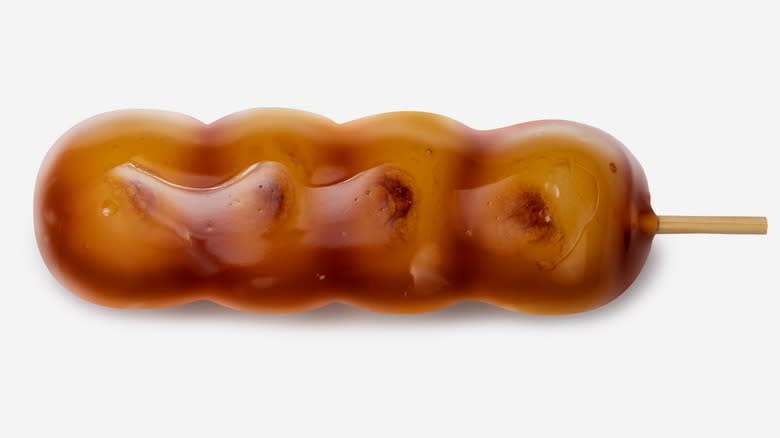
At first glance, ayame dango looks similar to its more famous relative, Kyoto's mitarashi dango. It, too, is grilled and covered in a glossy brown sauce. However, ayame dango's glaze gets its hue not from soy sauce but from brown sugar syrup and has a rich, lightly bitter flavor. If you want to make copycat ayame syrup at home, a simple 1:1 mix of brown sugar and water thickened by potato starch should do the trick.
Ayame dango originates from Toyama. It was once a specialty item at a Toyama-based sweetshop sold only during the iris-blooming season of early summer. Its popularity made it available year-round, but its origins are still reflected in its name, which translates to "iris."
Botchan Dango
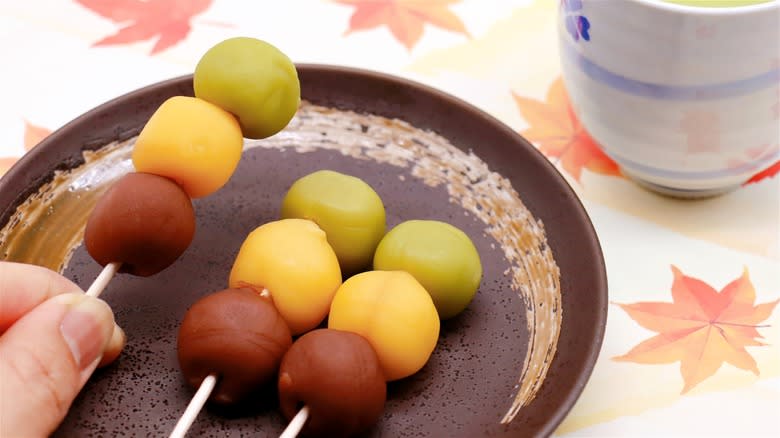
There are several types of three-colored dango, and botchan is one of them. It mixes three traditional wagashi flavors: red and white bean (the latter sometimes flavored with egg) and green tea. Today, it's an edible souvenir from Matsuyama, a city on the Shikoku island, where many shopping arcades and bath houses offer botchan dango. But the roots of this confectionery go back more than 100 years: This dango variety is named after Natsume Soseki's eponymous 1906 novel, where the protagonist loves to snack on it.
Some companies selling the confectionery have stopped using eggs to craft the sweets as early as 2005, making the authentic botchan dango completely vegan.
Cha Dango
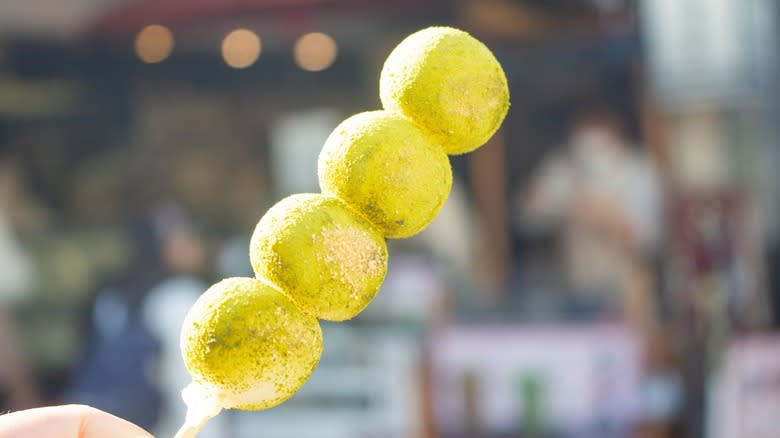
Since wagashi are usually paired with green tea, this dango variety will be a double treat for the ultimate matcha fans. As the name suggests, cha dango is flavored with matcha, which gives it a deep green hue. You can find it year-round in Japan or make it at home. You'll need to mix glutinous rice flour with water and knead until it forms an elastic dough, then steam it, knead and pound it, and mix it with powdered sugar and matcha before hand-rolling it into cylinders. Slice those up into small pieces, form the balls, skewer, and enjoy! As a finishing touch, you can top it with crushed tea leaves or dust it in with matcha powder to intensify its flavor and improve the presentation.
Denpun Dango
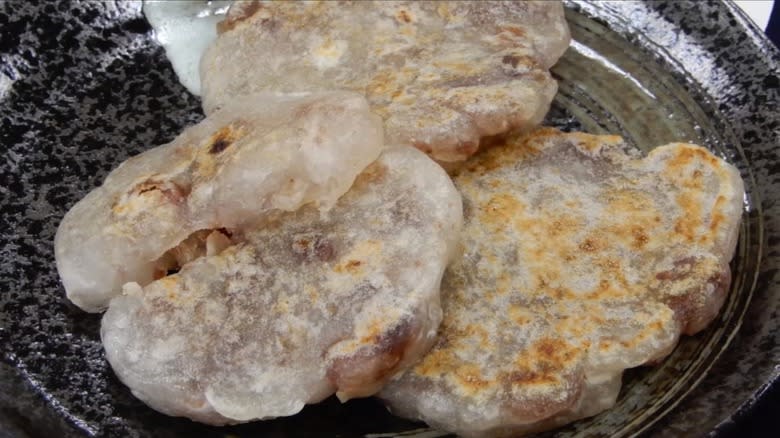
Should you ever find yourself in Hokkaido, where denpun dango originated, and order it from a pictureless menu, it is guaranteed to challenge your idea of dango as skewered rice flour balls. For one, it is made from potato starch, which is reflected in its name ("denpun" translates to "starch"). The starch is mixed with boiled and sweetened red beans and their cooking liquid until a thick batter forms. Then, it is ladled onto a hot griddle and cooked on both sides until lightly golden. This pancake-like dango is eaten as is or with a drizzle of honey. Fun fact: It's the first type of dango to ever grace the Guinness World Records after a Japanese local made a 254-pound version in Hokkaido in 2011.
Goma Dango
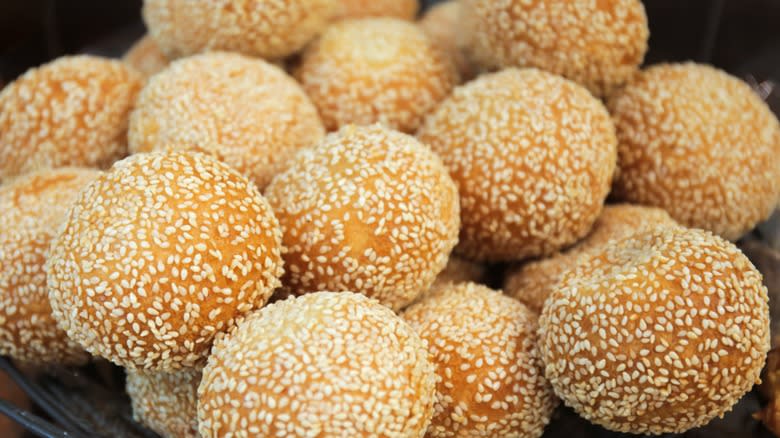
Have you ever heard of jian dui? It's a Chinese sesame seed dessert made from glutinous rice flour dough wrapped around various fillings, coated in sesame seeds, and deep-fried. In Japan, where it was rebranded as goma (sesame) dango, the filling of choice is the beloved sweet red bean paste, anko. Typically enjoyed at summertime street fairs, this type of dango is served straight out of deep frying. Its unique texture combines the expected stretchy and chewy insides with a crispy outer layer and a sesame crunch. Should you feel like making goma dango at home, follow the process for anko dango, but stuff the bean paste inside the dough balls instead of using it as a topping. Roll them in sesame seeds, deep-fry, and enjoy!
Hanami Dango
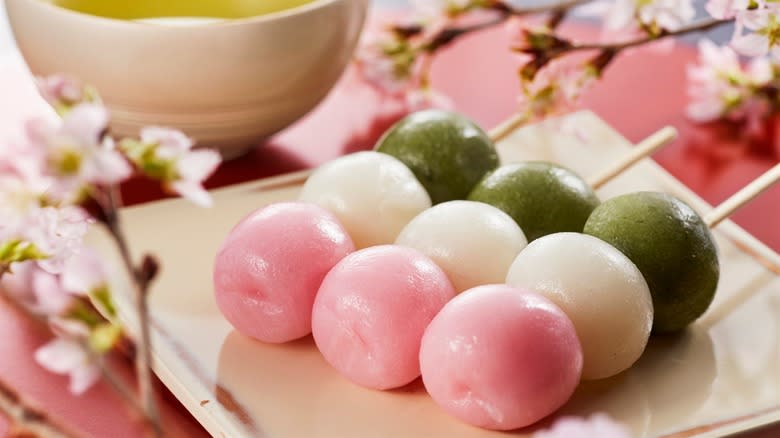
Forever immortalized in our collective consciousness in emoji form, hanami dango is one of the most famous wagashi. Typically enjoyed during springtime, it has been a mainstay of hanami (sakura viewing) picnics since the 16th century when it was introduced at Kyoto's Daigo no Hanami, the largest cherry blossom viewing party of its time.Hanami dango is also known as sanshoku dango, meaning it has three different colored balls. The tender hues of green, white, and pink can be seen as a reference to the color palette of early spring or the development stages of sakura flowers. The vibrant parts of hanami dango are traditionally dyed with natural ingredients, such as red shiso leaves and pickled cherry blossoms for the pink balls and mugwort powder for the green. However, you can use beet juice to get the pink color and matcha powder for the green.
Ikinari Dango
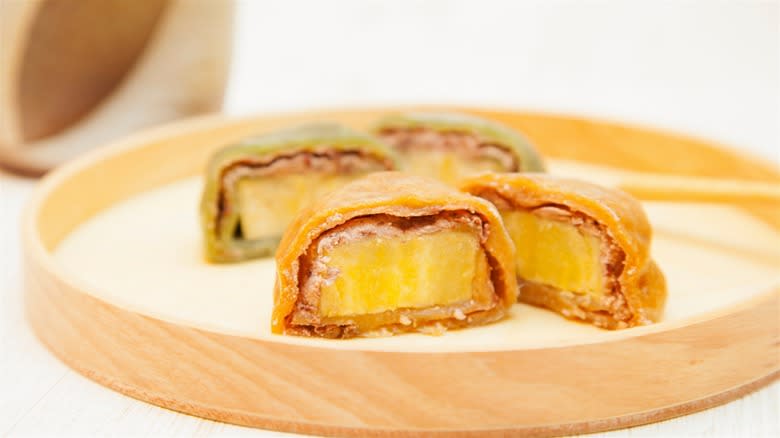
Originally a farmer's snack enjoyed during the sweet potato harvest season, ikinari dango eventually became a Kumamoto specialty available year-round, best eaten hot. At first glance, it looks more like a mochi due to its larger, flattened circular shape, but its filling might come as a bit of a surprise. Nowadays, it consists of a mixed rice-wheat dough wrapped around a piece of cooked starchy Japanese sweet potato, with some of the sweet red bean paste sneaked inside as well. However, anko is a recent addition, and the dough used to be solely wheat-based in times of scarcity. Its name, which translates to "suddenly," is believed to be a reference to ikinari dango being an easy meal to prepare for unexpected guests.
Isobe Dango
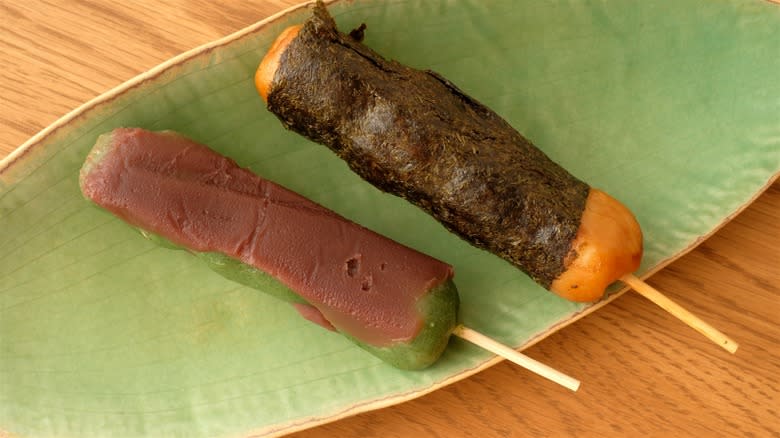
Those well-versed in different types of mochi might be familiar with isobeyaki mochi, comprised of flat, rectangular rice cakes doused in a sweet soy sauce glaze and wrapped in a piece of nori (seaweed). Though the word isobe translates to rocky shore or seaside, it has also come to mean foods wrapped in seaweed. Thus, isobe dango is made from unflavored rice flour balls that are grilled, brushed with plain or sweetened soy sauce, and wrapped in nori. If you're making isobe dango at home and don't have a grill, you can fry it in a non-stick pan until lightly golden. You can also finish it with a sprinkle of shichimi togarashi -- a spice blend that teriyaki lovers should be familiar with.
Kibi Dango
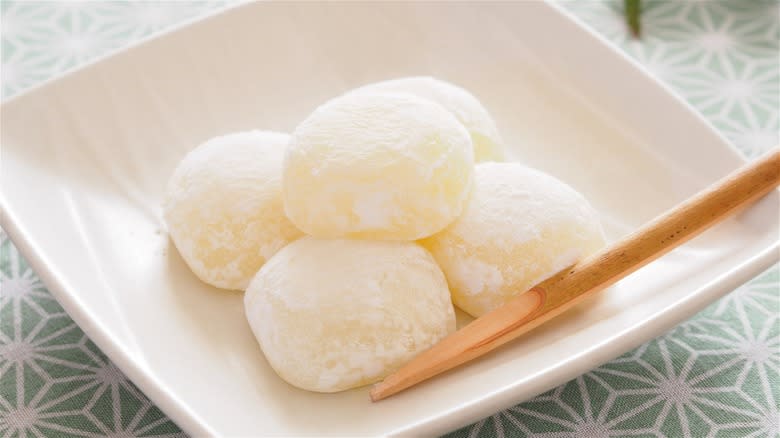
While kibi dango is a simple mochi-like confection, its origins and ingredients are a subject of heated debate. Some know it from the Japanese folk tale of Momotaro (Peach Boy), in which the protagonist shares his dango with a dog, a monkey, and a pheasant to recruit them to fight ogres alongside him. Though it has little in common with what is known as kibi dango today, Momotaro's legendary image is still used to sell them. The ancient Kibi province (present-day Okayama), specifically the Kibitsu Shrine, is thought to be its birthplace, perhaps because its name is a homophone of the Japanese word for "millet." Most modern-day kibi dango barely have any millet, though some recipes use a mix of rice and millet flours.
Kinako Dango
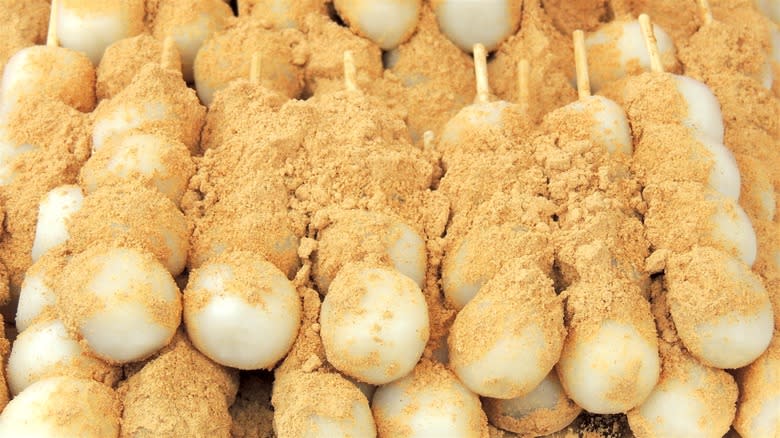
The titular flavor in this wintertime dango is roasted soybean flour, one of the essential ingredients for Japanese cooking. Its sand-like appearance might be unappealing to some, but its warm, nutty aroma is a perfect garnish for mildly sweet, natural-tasting wagashi. If the goal is to amplify rather than offset the sweetness of the dessert, sweet kinako — a 1:1 mix of flour and sugar — can be used. So, if you want to experiment with this ingredient, homemade kinako dango is a great place to start. You'll need to make a basic glutinous rice flour dough, form the balls, boil them, and roll them in soy flour. Kinako dango is usually plain, but you can try sprinkling the flour over cha or yomogi dango for a flavorful twist.
Kurumi Dango
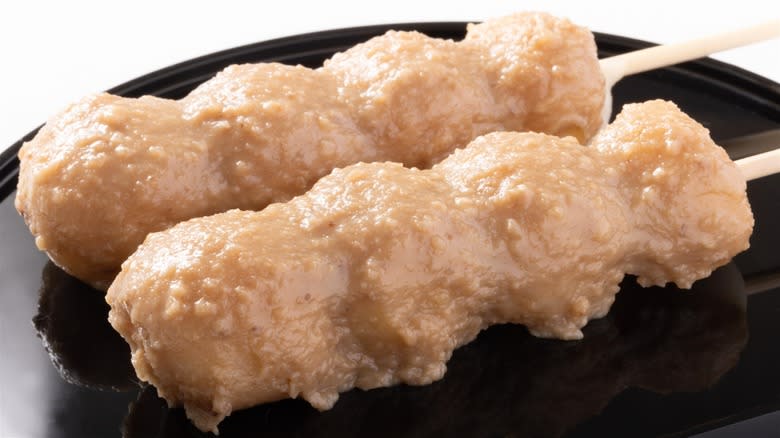
Nuts don't seem to take up a lot of space in local cuisine, but you'll be able to find certain regional specialties that will employ walnuts, or kurumi, as they're called in Japan. For example, Iwate prefecture is known for its kurumi zōni (a New Year's mochi soup served with walnut paste) and ocha mochi (skewered, pressed, and grilled mochi brushed with a mix of ground walnuts, soy sauce, and sugar). Kurumi dango is another example of mixing tender, chewy, plain rice flour treats with walnuts; in this case, they are simply steamed and served with a generous smear of walnut paste. The flavor and texture of the paste come from a mix of ground-roasted walnuts, shiroan (white bean paste), sugar, and soy sauce.
Misogi Dango
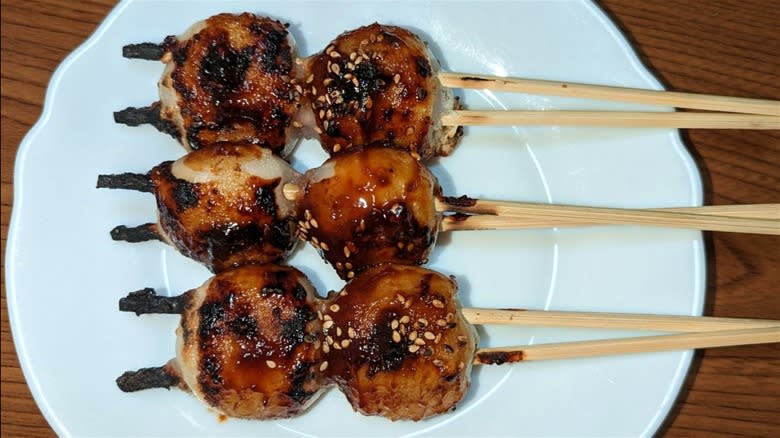
Hailing from Hashima City, this unique seasonal dumpling emerged in the esteemed Togetsuen confectionery shop in the early 20th century. Filled with sweet red bean paste, the skewered balls are grilled twice, the second time with sweet red miso paste. While it may not win any beauty contests, the allure of misogi dango lies in its complex flavors and the unmistakable aroma of charred miso. Originally known as miso tsuke dango, its name was later changed to misogi, referencing the flavor of dango while connecting it to the eponymous Shinto purification ritual, observed annually on June 30. The misogi dango becomes available around that time, and they say that by eating it during the ritual, you can avoid summer fatigue and stay well for the remaining six months.
Mitarashi Dango
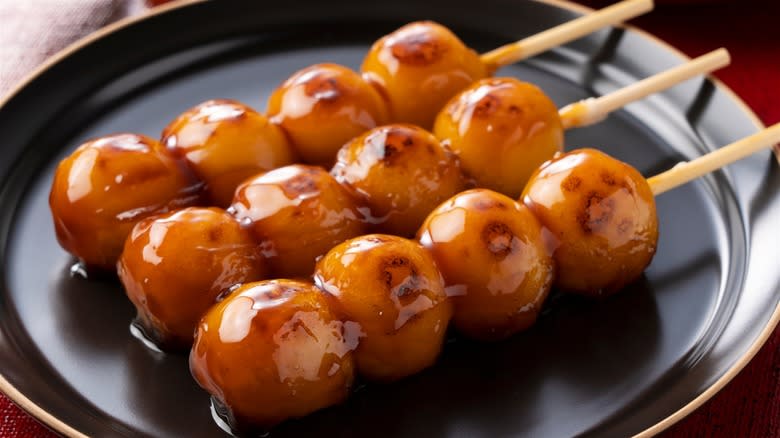
Hanami dango might have secured its place in popular culture with the emoji, but there's another Kyoto-born variety that is extremely popular. Unlike hanami dango, it is enjoyed year-round and has a rich, pronounced flavor: The thick, glossy, sweet soy sauce glaze is addictive and highlights the light char and smoky aroma of the grilled dumplings underneath.
Mitarashi dango typically consists of four or five dumplings. The number has been said to symbolize a man's head and limbs or the bubbles that appeared on the surface of the pond during an emperor's visit to the Mitarashi festival at Shimogamo shrine. The nearby wagashi shop, Kamo Mitarashi Chaya, is believed to be the birthplace of mitarashi dango, so if you ever visit Kyoto, be sure to pay a visit for an authentic bite.
Sasa Dango
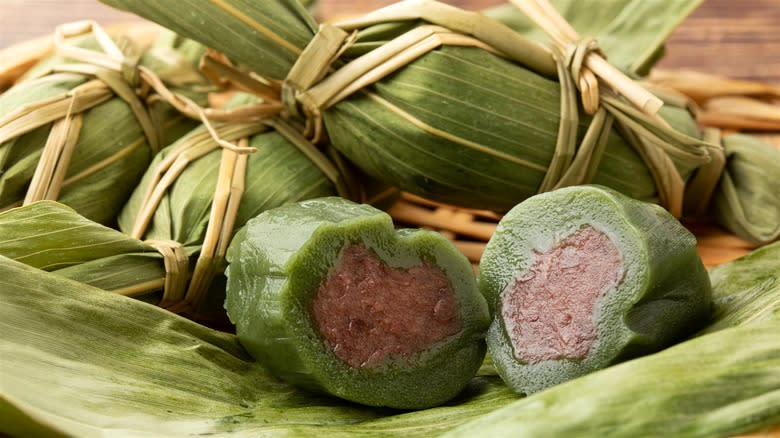
Sasa dango might boast an unusual bamboo-wrapped look, but it is made of familiar ingredients: sweet red bean paste encased in stretchy rice dough flavored with mugwort. Hailing from Niigata, a region renowned for its rice production, this humble dumpling is believed to have once served as a vital source of sustenance during wartime, tapping into the antibacterial properties of bamboo leaves. It was traditionally made by rice farmers from spring through fall, as bamboo and mugwort are in season at different times. With a history spanning over five centuries, this snack has transitioned from a traditional offering on Children's Day to a year-round favorite, available in various iterations, including the filling-free aemon dango, the anko-filled onna (female) dango, and otoko ("male") dango, featuring a filling of tofu, vegetables, and seaweed.
Shiratama Dango
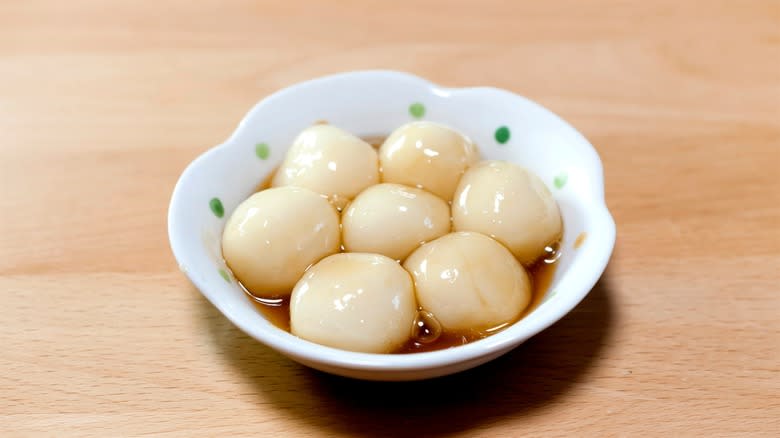
Like most other dango varieties, shiratama dango begins with the eponymous flour. However, you can mix the flour with moist silken tofu instead of water to add a little protein and help the dumplings stay soft longer once cooked. It's a dango base variety worth mastering at home to use in other dishes -- a 1:1 mix by weight of tofu to flour should do the trick. Next goes the usual kneading, shaping, and simmering. When ready, you can serve them with any traditional Japanese topping, from kinako to kuromitsu (a type of syrup made from Okinawa black sugar), or create something unique — shiratama dango is a wonderful neutral base for your ideas.
Soba Dango
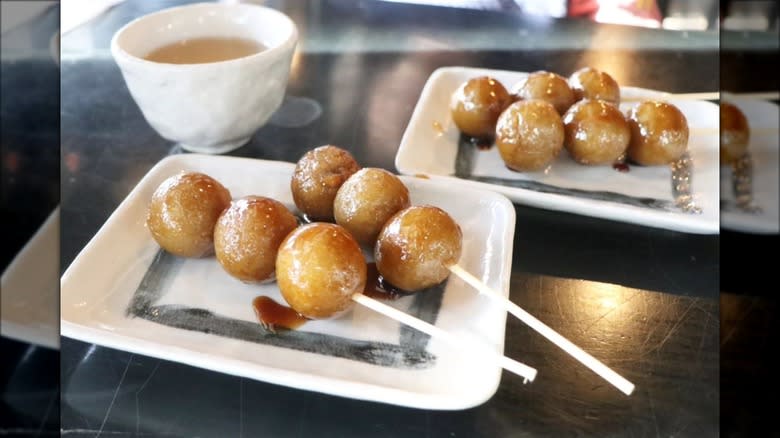
Soba dango, as the name hints, is all about buckwheat flour. Unlike dango made with glutinous rice flour, these little dumplings rock an uneven surface akin to meatballs, with a distinct fluffy and crisp texture. Once they're boiled and grilled, these unassuming dango are ready to join the supporting cast of Japanese culinary ensembles. The flour brings a light, gentle flavor that allows soba dango to play double duty, appearing in savory dishes like zōni, a Japanese wintertime must-try, or skewered and paired with a wild sesame miso sauce. However, it still perfectly matches with anko, kinako, and sweet, mitarashi-style sauce. At Japanese restaurants and ryokans, soba dango gets the VIP treatment, topped with a lineup of seasonal plants and fungi submerged in soy sauce-based broth.
Suhama Dango
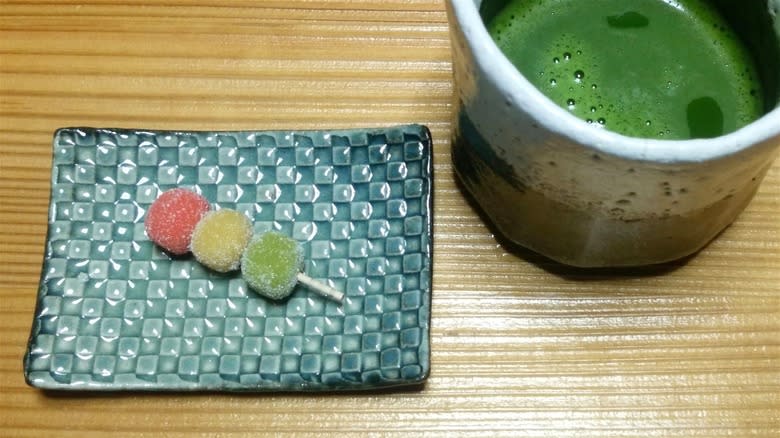
Another three-colored variety from Kyoto, suhama dango is like a little sugar-coated traffic light. Its distinctive feature is that it uses roasted soybean flour instead of glutinous rice flour as the base for the dough. Perhaps it was this sand-like base that earned suhama dango its name, which translates to sandy beach or a wavy sandbar. To achieve the traffic light look, the balls can be tinted using artificial or natural food coloring. What's more, suhama dango employs mizuame syrup instead of sugar. This clear, shiny, glutinous starch-based liquid, has a one-note flavor similar to corn syrup, but is capable of introducing starch to the mix, effectively providing structure to the dough.
Tsukimi Dango
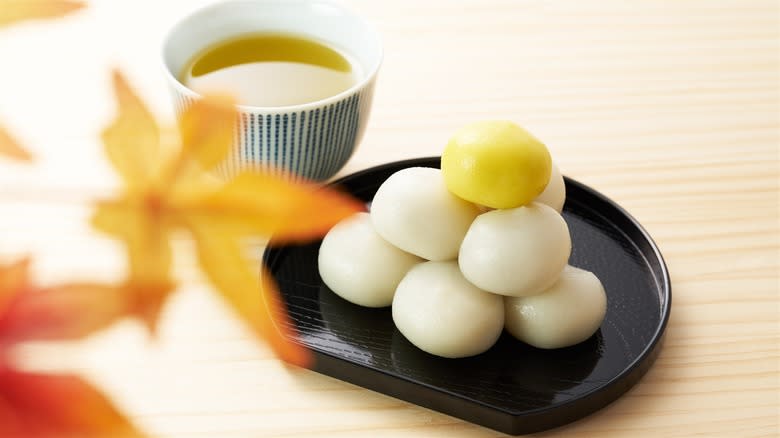
Hanami, or cherry blossom viewing, was introduced into your vocabulary earlier, but have you heard of tsukimi? It literally translates to moon viewing, and in Japan, there is a whole festival for it. People gather to celebrate the full moon's beauty -- though this isn't just any old moon, but a harvest moon, which occurs around the time of the fall equinox. And, of course, where there's a special celebration, there must be special food. Tsukimi dango is one of the signature dishes prepared for the occasion, offered to the moon alongside seasonal fruits and vegetables as a symbolic gesture of gratitude for an abundant harvest. They are presented in a pyramid shape comprised of 15 plain white dumplings (sometimes the top one will be yellow to represent the moon) constructed on a designated wooden plate stand.
Uguisu Dango
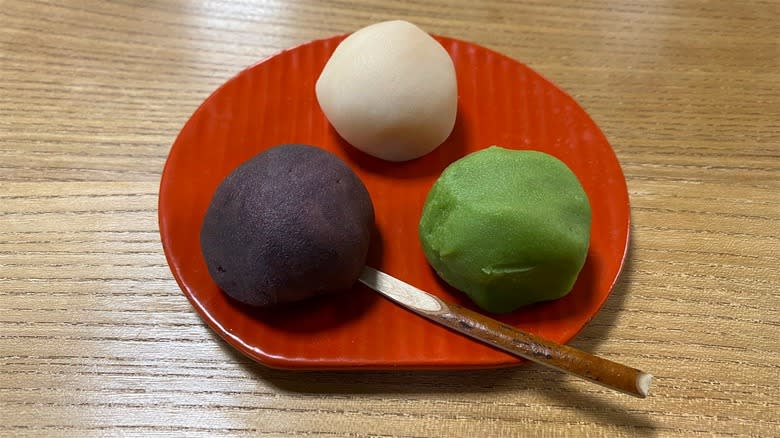
Some dango varieties are known and loved nationwide, others are treasured regional specialties, and some are so location-specific that you can only get them in one place. Uguisu dango is a bit of everything. Often linked to Shin-Uguisu Tei, a traditional cafe nestled in one of Japan's oldest public parks, Tokyo's Ueno Park, the titular three-colored dish has been on the menu since its opening days in 1915. The word "uguisu" means "nightingale," or, more precisely, Japanese Bush Warbler, a small songbird of cream, olive, and brown plumage, which sings in early spring. These colors are reflected in uguisu dango, flavored with matcha, koshian, shiroan, and red millet, all a delightful match for green tea.
Yomogi Dango
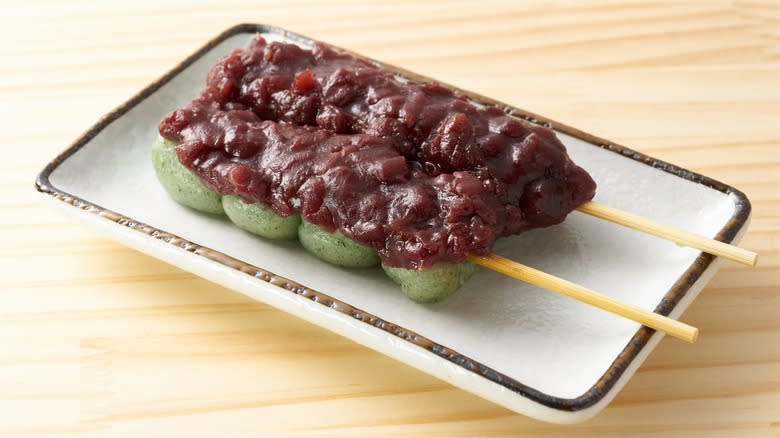
When you see a green-colored dango, what flavor do you imagine? Probably not mugwort! And yet, this refreshing, lightly bitter, seasonal herb known as yomogi is the key to this dango's unique taste. The Japanese word kusa translates to "grass" or "herb," so its alternative name, kusa dango, is another nod to its herbal composition. To offset the earthiness of mugwort, yomogi dango is often served smeared with anko (while a similar dessert, kusa mochi, uses it as a filling) or dusted with sweet kinako. A specialty of Tokyo's Shibamata neighborhood since the Edo period, this springtime treat is still available for purchase from street vendors and cafes on Taishakuten Sandō -- a shopping street that leads to the eponymous temple, whose visitors helped popularize yomogi dango back in the day.
Zunda Dango
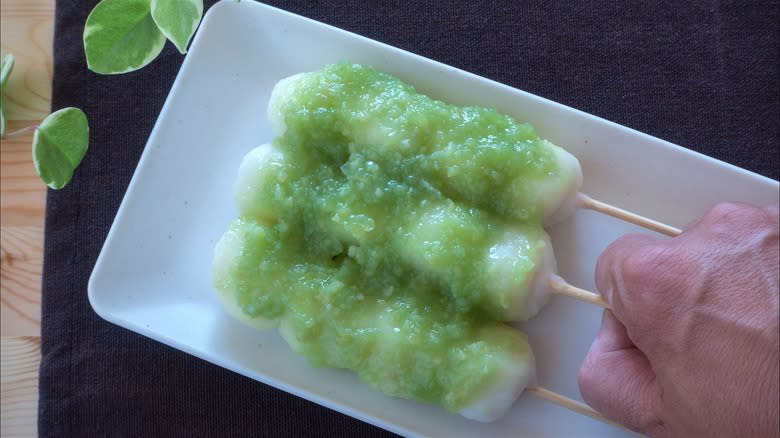
Soybeans are the backbone of Japanese cooking, where they find plenty of sweet and savory applications. When their sweet, buttery, green teenage version — edamame — is mashed into a paste, it becomes zunda. Residents of Sendai city in the Miyagi prefecture are very fond of zunda mochi, fresh plain rice cakes generously smeared with or coated in a sweet edamame mash. This dish is typically served chilled during the summer when edamame is in season. But plenty of other snacks incorporate zunda, from taiyaki to daifuku and, of course, dango. Its concept is not unlike anko dango -- but instead of a red bean paste, white rice flour dumplings are topped with edamame paste, which offers a refreshing, summertime alternative.
Static Media owns and operates Tasting Table and Mashed.
Read the original article on Tasting Table


